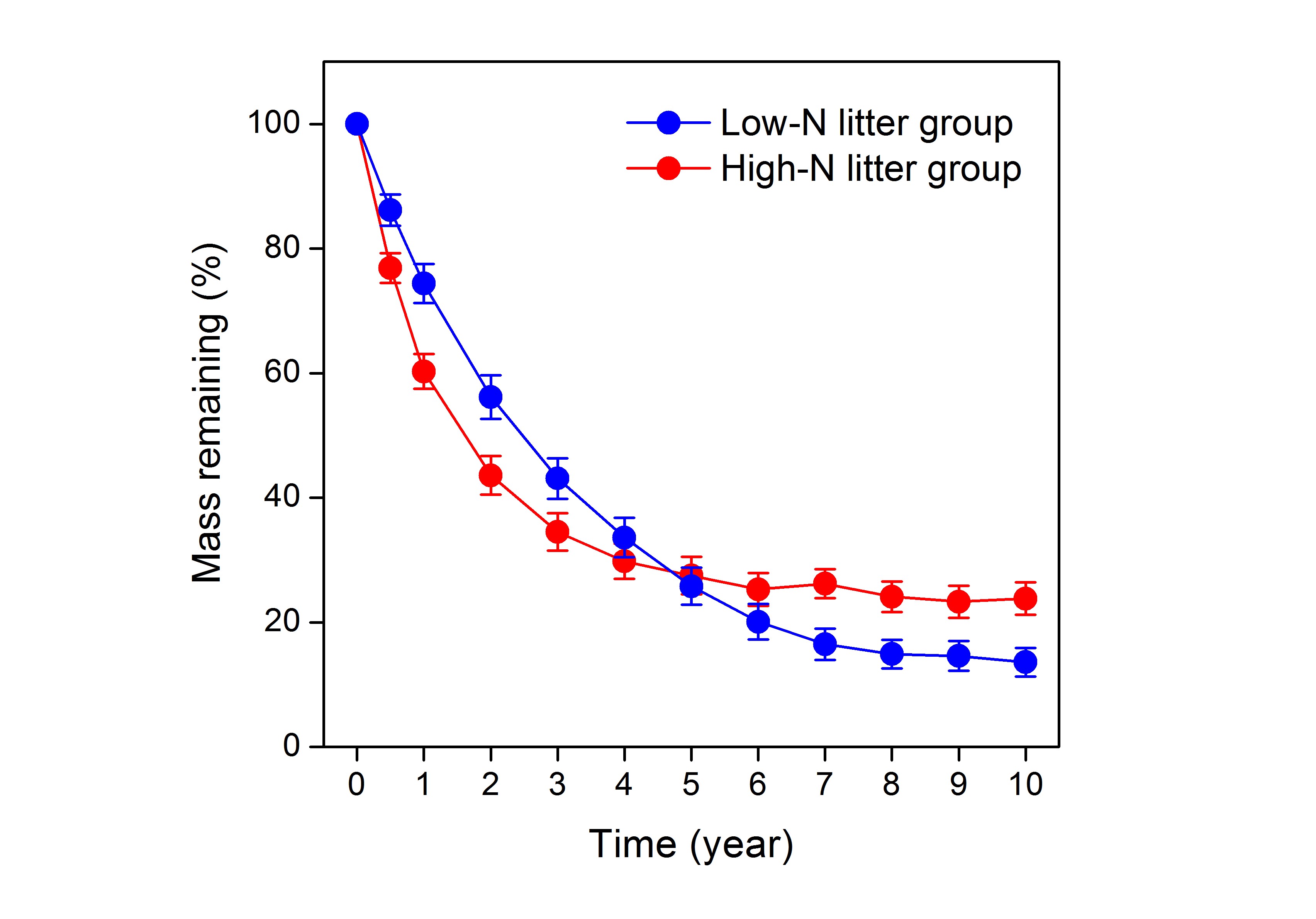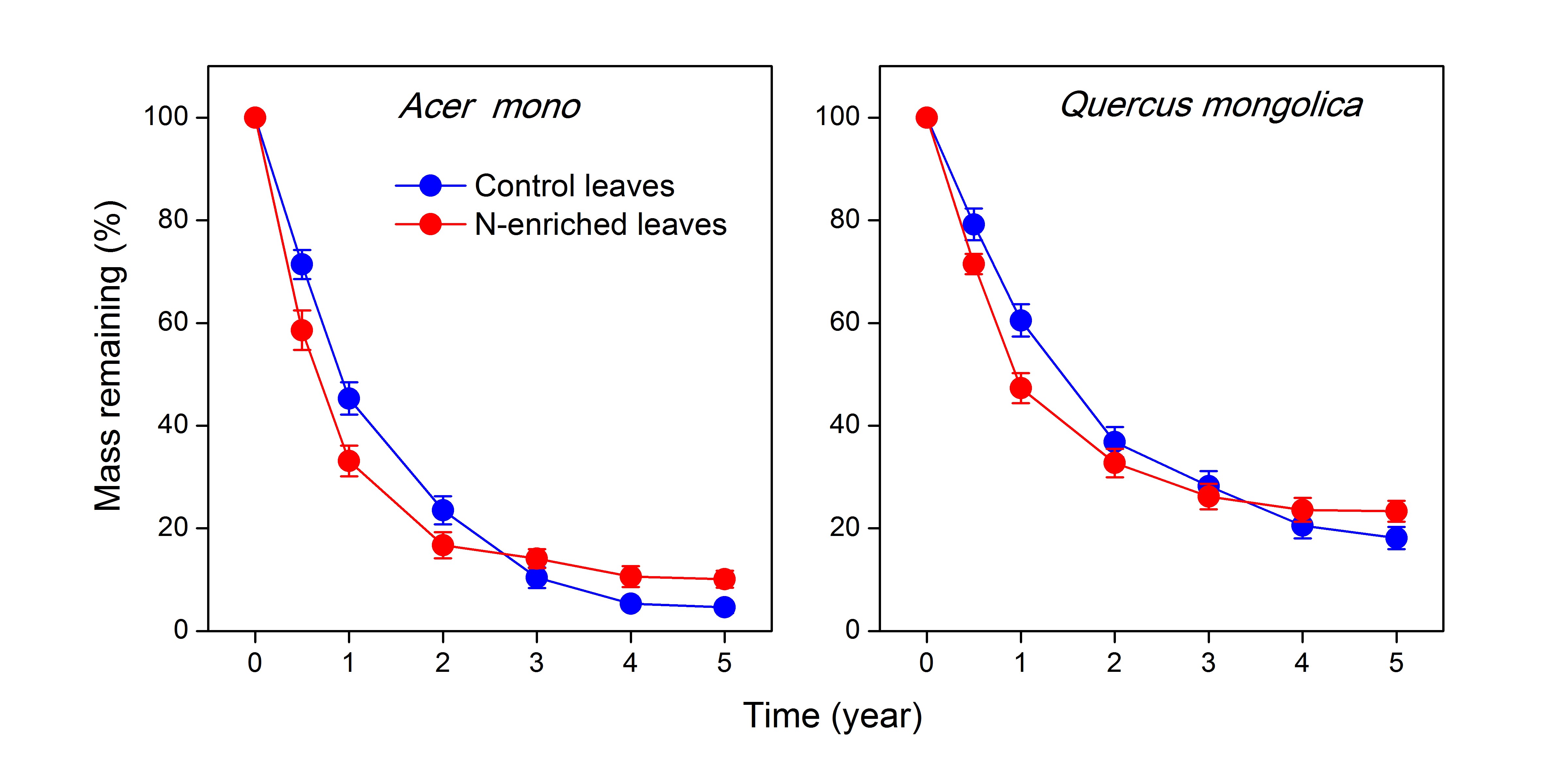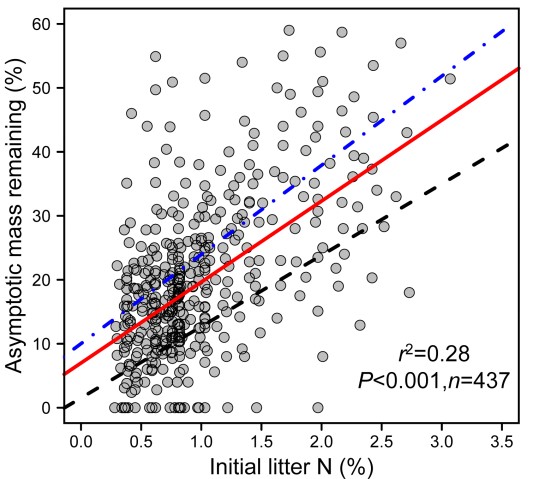New Study Finds the General Reversal of N-decomposition Relationship During Long-term decomposition
Playing out over years to decades, litter decomposition is a slow process that is fundamental to carbon (C) and nutrient cycling in terrestrial ecosystems. Numerous studies have shown that the availability of N should play a critical role in regulating the rate of plant litter decomposition and the positive relationships between substrate N concentrations and decomposition have been embedded into ecosystem models. However, this decomposition paradigm relies on data mostly from short-term studies analyzing controls on early-stage decomposition, leading to an incomplete understanding of decomposition, and resulting the uncertainty of ecosystem carbon dynamics, especially in boreal and temperate forests where decomposition is slow. Based on long-term in-situ decomposition, long-term leaf-based N fertilization, and meta-analysis, the Forestry Ecological Engineering (Underground) team of the Northern Ecological Barrier Function Formation and Maintenance Mechanism and Quality and Efficiency Innovation Group of the Institute of Applied Ecology of Shenyang, Chinese Academy of Sciences has made new progress in the mode and mechanism on N regulation of long-term decomposition of litter in temperate forests.
Higher N concentrations were associated with faster decomposition initially, but ultimately suppressed the decomposition rates of late-stage by resulting in a larger recalcitrant fraction. First, based on a 10-year decomposition experiment with leaf litter from 62 woody species from a Chinese temperate forest, they found that leaf litter with higher N concentrations decomposed faster than that with lower N concentrations initially. However, after five years, the pattern reversed such that the amount of initial litter mass remaining on average was approximately 1.78 times greater for the higher-N species than for the lower-N species by the end of 10 years of decomposition (Figure. 1). Amino sugars is a widely accepted biomarker. After five years of decomposition, the concentrations of amino sugars, a proxy for microbial residue abundance, were indeed higher in high-N litter than in low-N litter. Across 60 species studied, the values of asymptotic mass remaining correlated positively with the concentration of amino sugars (Figure. 2). This result suggested a potential mechanism for the observed negative effect of litter N concentration on the later stages of decomposition: the greater accumulation of microbial products from labile litter components is an important process inhibiting later stages of decomposition. They then conducted an N-enrichment experiment in two tree species of contrasting leaf lignin concentrations (Acer mono and Quercus mongolica) to manipulate more directly litter N concentrations and to examine whether experimentally N-enriched litter showed the same faster initial decomposition rates but greater asymptotic mass remaining when compared to litter of that same species that was not experimentally N-enriched. During the 6-year decomposition period, the initial decomposition rate of N-rich leaves was faster, but decreased after 3 years (Figure 3), confirming the reversal of the N concentration-decomposition relationship over time within the same species.

Figure 1. Average percent mass remaining as a function of time for low-N (N < 1.39%, n = 33 species, blue) and high-N (N > 1.39%, n = 29 species, red) litter decomposing in a temperate forest (Image by SUNTao).

Figure 2. Asymptotic mass remaining as a function of total amino sugars across 60 species after five years of decomposition (Image by SUNTao).

Figure 3. Average mass remaining for decomposing control (red) and experimentally N-enriched (blue) leaves of two temperate tree species as a function of time (Image by SUNTao).
A general negative relationship between N concentration and later stage of decomposition exist in boreal and temperate forests. They subsequently compiled a new data set derived from 32 published long-term decomposition studies involving 437 measurements from 120 species in 45 boreal and temperate forest sites to test whether a general relationship between litter N and asymptotic mass remaining exists in boreal and temperate forests. Litter N concentrations varied 11-fold and correlated positively with the values of asymptotic mass remaining across species and studies (Figure 4).

Figure 4. Asymptotic mass remaining as a function of initial litter N concentrations collected from 32 published long-term decomposition studies (average duration of 7 years, minimum of 4 years and maximum of 12 years) in boreal and temperate forests. These studies covered litter from 120 species and 45 sites. Dashed lines show the 25th (black single-dashed) and 75th (blue double-dashed) quantile regressions and red solid line shows the median regressions (r2=0.28, P<0.001) (Image by SUNTao).
These results challenge the current treatment of interactions between N and decomposition in many ecosystems and Earth system models, and highlight the need to include the contrasting effects of substrate N on different decomposition phases into ecosystems and Earth system models, which provide the correct understanding of decomposition, and decreasing the uncertainty of ecosystem carbon estimation. The contrasting effects of substrate N on different stages of decomposition demonstrated here are critical for both understanding and improving predictions of the future carbon cycle under elevated atmospheric N deposition, changing climatic conditions, and other environmental shifts.
Entitled General reversal of N-decomposition relationship during long-term decomposition in boreal and temperate forests. Prof. Tao Sun from Shenyang Institute of Applied Ecology is the co-first authors of this paper, along with Prof. Bjorn Berg from the University of Helsinki, Finland. Prof. William H. Schlesinger (Duke University, USA) and Researchers Tao Sun and Jiaojun Zhu (Shenyang Institute of Applied Ecology) are corresponding authors of the paper. This research was supported by National Key R&D Program of China, and the Excellent Member of Youth Innovation Promotion Association of CAS to Tao Sun.



